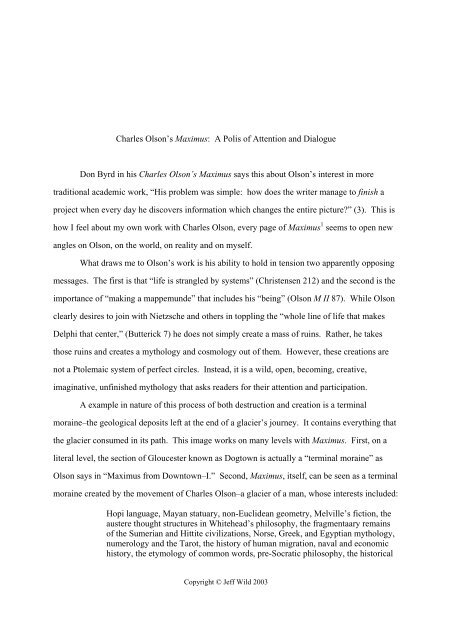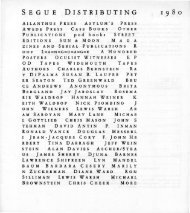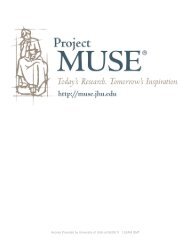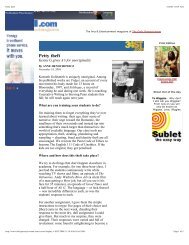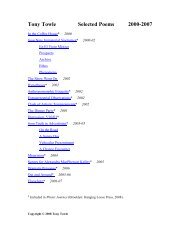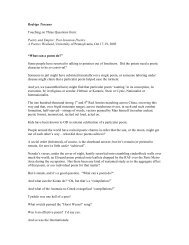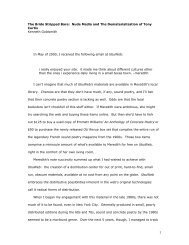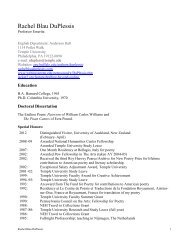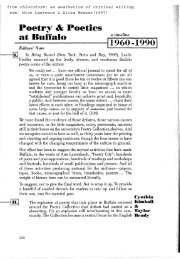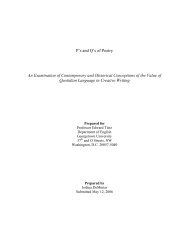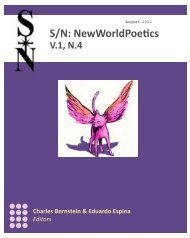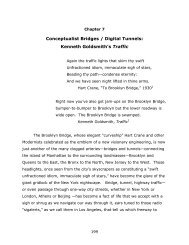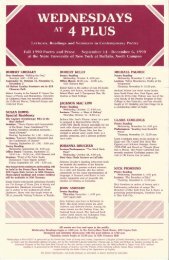Charles Olson's Maximus - Electronic Poetry Center
Charles Olson's Maximus - Electronic Poetry Center
Charles Olson's Maximus - Electronic Poetry Center
You also want an ePaper? Increase the reach of your titles
YUMPU automatically turns print PDFs into web optimized ePapers that Google loves.
<strong>Charles</strong> Olson’s <strong>Maximus</strong>: A Polis of Attention and Dialogue<br />
Don Byrd in his <strong>Charles</strong> Olson’s <strong>Maximus</strong> says this about Olson’s interest in more<br />
traditional academic work, “His problem was simple: how does the writer manage to finish a<br />
project when every day he discovers information which changes the entire picture?” (3). This is<br />
how I feel about my own work with <strong>Charles</strong> Olson, every page of <strong>Maximus</strong> 1 seems to open new<br />
angles on Olson, on the world, on reality and on myself.<br />
What draws me to Olson’s work is his ability to hold in tension two apparently opposing<br />
messages. The first is that “life is strangled by systems” (Christensen 212) and the second is the<br />
importance of “making a mappemunde” that includes his “being” (Olson M II 87). While Olson<br />
clearly desires to join with Nietzsche and others in toppling the “whole line of life that makes<br />
Delphi that center,” (Butterick 7) he does not simply create a mass of ruins. Rather, he takes<br />
those ruins and creates a mythology and cosmology out of them. However, these creations are<br />
not a Ptolemaic system of perfect circles. Instead, it is a wild, open, becoming, creative,<br />
imaginative, unfinished mythology that asks readers for their attention and participation.<br />
A example in nature of this process of both destruction and creation is a terminal<br />
moraine–the geological deposits left at the end of a glacier’s journey. It contains everything that<br />
the glacier consumed in its path. This image works on many levels with <strong>Maximus</strong>. First, on a<br />
literal level, the section of Gloucester known as Dogtown is actually a “terminal moraine” as<br />
Olson says in “<strong>Maximus</strong> from Downtown–I.” Second, <strong>Maximus</strong>, itself, can be seen as a terminal<br />
moraine created by the movement of <strong>Charles</strong> Olson–a glacier of a man, whose interests included:<br />
Hopi language, Mayan statuary, non-Euclidean geometry, Melville’s fiction, the<br />
austere thought structures in Whitehead’s philosophy, the fragmentaary remains<br />
of the Sumerian and Hittite civilizations, Norse, Greek, and Egyptian mythology,<br />
numerology and the Tarot, the history of human migration, naval and economic<br />
history, the etymology of common words, pre-Socratic philosophy, the historical<br />
Copyright © Jeff Wild 2003
Copyright © Jeff Wild 2003<br />
A Polis of Attention and Dialogue<br />
origins of the New England colonies, the development of the fishing industry off<br />
the coast of Massachusetts, accounts of the conquest of Mexico, the collapse of<br />
the Aztec and Mayan civilizations. (Christensen 5-6)<br />
Finally, the image of the terminal moraine also resonates with the view of the mythologist,<br />
Joseph Campbell, who used this image as a description of the state of myth in our time.<br />
Campbell imagined that individuals in the twentieth century were standing on a terminal moraine<br />
containing the fragments of thousands of years of myth. 2 And from this great treasure chest of<br />
myth he encouraged individuals to create their own personal mythology by picking and choosing<br />
from what lies about them. It is with a similar sentiment that Olson writes <strong>Maximus</strong>.<br />
What holds this mass of fragments together for Olson is the actual city of Gloucester<br />
“where he grew up summers as a boy and where he would settle following the closing of Black<br />
Mountain College in 1957” (Butterick 8). It is the central geographical and historical focus of<br />
<strong>Maximus</strong>. For Olson, Gloucester is his polis, his “city-state, esp. in ancient Greece; spec. such a<br />
State considered in its ideal form” as defined by The New Shorter Oxford English Dictionary.<br />
While the Greek polis is certainly the best known and largest organization of city-states,<br />
which at one time numbered “some 1500 independent states” (Griffith and Thomas 31), it is not<br />
the only culture where this type of government could be found as the book, The City-State in<br />
Five Cultures, makes clear. In fact, Sumer, one of Olson’s favorite subjects is the earliest culture<br />
identified as having city-states. In Sumer there was a democratic process which “was in perfect<br />
harmony with the Sumerian understanding of the world of celestial beings, who made all of their<br />
crucial decisions through a celestial assembly from decisions to create or to destroy, promote or<br />
demote” (Griffith and Thomas 17).<br />
By looking at the city-states across these various cultures, one finds four characteristics<br />
that can be considered defining points. First, there was a defined core, the city, which was<br />
usually enclosed by walls or surrounded by water. Second, the city-states strove for economic<br />
self-sufficiency. Third, there was a fundamental sense of shared language, culture and history.<br />
And finally, each polis regarded itself as an independent, self-governing polity.
Copyright © Jeff Wild 2003<br />
A Polis of Attention and Dialogue<br />
If one turns to <strong>Maximus</strong> and playfully considers it in light of these four characteristics,<br />
one can see that the poem seemingly possesses a number of them. First, it has a defined core–<br />
Gloucester–around which Olson tries “to build out of sound the wall / of a city,” (M III 37).<br />
Second, when readers step into the walls of <strong>Maximus</strong>, they become citizens of the poem who<br />
share its language, culture and history. And finally due to the breadth of subject matter of<br />
<strong>Maximus</strong> Olson is able to give the reader the sense that the poem is an independent and self-<br />
governing polity with its own history and sociological structure.<br />
Within <strong>Maximus</strong>, itself, Olson offers his own perspectives on the notion of polis. In<br />
“Letter 3” of <strong>Maximus</strong> Olson writes, “As the people of the earth are now, Gloucester / is<br />
heterogeneous, and so can know polis / not a localism.” Later, in that same letter, he writes, “I<br />
speak to any of you, not to you all, to no group, not to you as citizens / as my Tyrian might have.<br />
Polis now / is a few, is a coherence not even yet new (the island of this city / is a mainland now<br />
of who? who can say who are / citizens?” (M II 10).<br />
Before turning to Olson’s apparent answer to this question, an exploration of the<br />
citizenship criteria of the Greek polis reveals that the citizens of those poleis were also a “few.”<br />
In fact one estimate of the percentage of people living within a Greek polis who were actually<br />
voting members, states that there was a “2.63 percent citizenship for Sparta and 13.6 percent for<br />
Athens” (Griffith and Thomas 47). In Greece the two main factors for polis citizenship were<br />
“that an individual belonged to both a community of people and community of place: the first<br />
proof was offered through descent and the second was attested by means of ownership of<br />
property” (Griffith and Thomas 48).<br />
For Olson the polis could include a much more diverse collection of individuals, such as<br />
“Nova Scotians, / Newfoundlanders, / Sicilianos, / Isolatos” (M I 12). What these people had in<br />
common was the quality of their “eyes,” the quality of their attention. Olson writes:<br />
polis is<br />
eyes<br />
. . .
Eyes,<br />
& polis,<br />
fishermen,<br />
& poets<br />
or in every human head I’ve known is<br />
busy<br />
both:<br />
the attention, and<br />
the care<br />
however much each of us<br />
chooses our own<br />
kin and<br />
concentration<br />
. . .<br />
so few<br />
have the polis<br />
in their eye<br />
(M I 26)<br />
Copyright © Jeff Wild 2003<br />
A Polis of Attention and Dialogue<br />
Byrd, calls this quality of attention, “a radical phenomenology . . . The fishermen provide a<br />
model of perceptual precision and care for both the city . . . and the poet. . . . <strong>Maximus</strong> insists<br />
upon the absolute primacy of the visual” (81). Attention is so important to Olson that Paul<br />
Christensen calls Olson’s <strong>Maximus</strong> “the apostle of total awareness” (123).<br />
With attention as the key criteria for citizenship in Olson’s polis, it leads to a reality in<br />
which “there are no hierarchies, no infinite, no such many as mass, there are only / eyes in all<br />
heads, / to be looked out of” (M I 29). This lack of hierarchy connects back to the original Greek<br />
poleis, which were governed by the people and asked much of those individuals. Each polis<br />
“demanded and received direct participation . . . The polis had assumed certain responsibilities<br />
for the welfare of its members; but, lacking an elaborate administrative structure, it demanded<br />
the time and expertise of its citizens to execute those responsibilities” (Griffith and Thomas 67).<br />
This level of involvement was a new experience for these citizens and so required new<br />
skills, such as the ability to express oneself well in public. It was to address this need that the<br />
Sophists came into being:<br />
The Sophists were Greece’s first professional teachers, and they originated in<br />
response to the rise and spread of democracy, which made it important for
Copyright © Jeff Wild 2003<br />
A Polis of Attention and Dialogue<br />
citizens to learn how to express themselves well in the forum of public opinion<br />
(public opinion does not exist in an authoritarian state nor would it have existed<br />
in Plato’s ideal Republic). Their aim was therefore practical: to teach abilities<br />
that would enable citizens to lead a good social life in a free society. (Madison<br />
1982 245)<br />
This description certainly doesn’t sound like the Sophists for whom sophism–a “plausible but<br />
fallacious argument, esp. one intended to deceive or to display ingenuity in reasoning”–was<br />
coined. The definition of a “Sophist” from The New Shorter Oxford English Dictionary is<br />
slightly more inclusive in its description and actually contains a synopsis of the changing<br />
perspective on the Sophists. It states, “In ancient Greece, a scholar, a teacher; spec. a paid<br />
teacher of philosophy and rhetoric, esp. one associated with specious reasoning and moral<br />
skepticism; gen. (now rare) a wise or learned man. Now, a person using clever but fallacious<br />
arguments; a specious reasoner, a casuist.” So if the Sophists were teachers trained to help<br />
individuals carry out the duties of a democracy, how did the change in their reputation occur?<br />
How did they become associated with “fallacious arguments”? Well, as the saying goes,<br />
“Winners write history.” Many of the Sophists were contemporaries with Plato and were in<br />
conflict with him as is evident from the Dialogues, in particular Gorgias and Phaedrus. And<br />
since Plato’s writings survived and “no writings survived from any of the sophists . . . we have to<br />
depend on inconsiderable fragments and often obscure or unreliable summaries of their<br />
doctrines. What is worse, for much of our information we are dependent upon Plato’s<br />
profoundly hostile treatment of them” (Kerford 1). The contemporary postmodern philosopher<br />
G. B. Madison describes it this way:<br />
So thorough was Plato’s victory that today the word sophist is synonymous with<br />
dishonesty and specious argumentation; sophistry designates any form of<br />
plausible but fallacious argument. The sophist, we say, is one who through slick<br />
talking can make someone believe that black is white; he is interested only in his<br />
own personal gain and, as Plato said of one of the greatest of Sophists, Gorgias,<br />
he respects probability more than truth, make trifles seem important and<br />
important points trifles by the force of his language, dresses up novelties as<br />
antiques and vice-versa, and argues concisely or at interminable length about<br />
anything and everything. (1982 244)
Copyright © Jeff Wild 2003<br />
A Polis of Attention and Dialogue<br />
But this was not simply a battle between two schools of philosophers, in many ways it<br />
was a battle over the nature of Truth and Reality. Plato through the Dialogues and the powerful<br />
imagery within them, created an eternal realm of Forms of which our experiential world is a<br />
mere reflection, an imperfect shadow. While most people have to be content with mere shadows,<br />
the philosophers (Plato being the pre-eminent philosopher) were “capable of apprehending that<br />
which is eternal and unchanging,” while others were incapable of this, and so were lost and<br />
wandered amid the “multiplicities of multifarious things” (484b). Philosophers were the only<br />
ones able to “fix their eyes on the absolute truth, and always with reference to that ideal and in<br />
the exactest possible contemplation of it establish in this world also the laws of the beautiful, the<br />
just, and the good” (484b). Not a bad spot to be in if you are a “philosopher.” Because of this<br />
special access to the Truth, Plato determined that the leaders of his republic should be<br />
philosophers. Plato’s notion of Truth is the beginnings of what now is known as a referential or<br />
representational view of reality. In this view of reality, reality is separated from language and<br />
from those using language. This separation allows language to have the task of mirroring reality.<br />
Therefore, words are judged true or false by their ability to accurately mirror an objective reality.<br />
For Plato it was philosophers who could “see” reality and so describe it accurately. For today’s<br />
society it is scientists who seemingly have taken over the role as keeper of the “accurate” picture<br />
of reality.<br />
The Sophists, on the other hand, were quite “postmodern” and did not claim to have<br />
access to the Truth. Due to their work with people, the Sophists came to realize that each person<br />
to some degree possessed a new sense of reality, a new set of absolutes, and it was the task of the<br />
Sophists to help people express that vision most clearly and persuasively. And so they<br />
envisioned an incomplete, ambiguous, and uncertain world, interpreted and<br />
understood by means of language. According to the sophists, truth and reality do<br />
not exist prior to language but are creations of it. . . . The sophists valued<br />
figurative and poetic language in particular because of its capacity to appeal<br />
directly to the senses through images, thus providing alternative possibilities for<br />
seeing and doing. (Foss, Foss and Trapp 3)
Copyright © Jeff Wild 2003<br />
A Polis of Attention and Dialogue<br />
The Sophist’s interest in “poetic language” was not all they shared with poets, who were also<br />
viewed quite contemptuously by Plato. For Plato the Sophists’ notion of truth as uncertain,<br />
ambiguous, incomplete, filled with interpretation did not fit in his neatly organized republic.<br />
And neither did poetry’s version of truth, since he had “come to see that we must not take such<br />
poetry seriously as a serious thing that lays hold on truth,” but instead must be on our guard<br />
“fearing for the polity” of our soul (Plato 608a-b).<br />
So if one sketches this debate that started with Plato as a debate between representational,<br />
objective Truth versus poetic, interpreted truth, one can easily see on what side of the debate<br />
Olson places himself. His attempt to define a poetic that creates an open stance toward reality is<br />
his response to the debate. In the essay “Human Universe,” Olson writes with urgency about<br />
Plato and the danger of his version of Truth, “His world of Ideas, of forms as extricable from<br />
content, is as much and as dangerous an issue as are logic and classification, and they need to be<br />
seen as such if we are to get to some alternative to the whole Greek system” (SW 1967 55).<br />
Olson places this issue right in the center of <strong>Maximus</strong> with the choice of <strong>Maximus</strong> of<br />
Tyre, a second century A.D. Greek philosopher as the “figure of speech” for his epic. Olson<br />
describes <strong>Maximus</strong> of Tyre as “some sort of a figure that centers much more than the second<br />
century A.D.–in fact, as far as I feel it, like, he’s the navel of the world. In saying that I’m not<br />
being poetic or loose. We come from a whole line of life that makes Delphi that center . . . and<br />
this I think is the kind of a thing that ought to be at least disturbed” (Butterick 7). In the Preface<br />
to the writings of <strong>Maximus</strong> of Tyre that Olson read just before beginning <strong>Maximus</strong>, we find these<br />
words:<br />
He cultivated philosophy, and principally that of Plato; and that he was one of<br />
those sophists who, like Dio Chrysostom, united philosophy with the study of<br />
rhetoric, and combined sublimity and depth of conception with magnificence and<br />
elegance of diction.<br />
I have said that he principally cultivated the Platonic philosophy, because<br />
from the twentieth dissertation it appears that he preferred the cynic life to that of<br />
all others, thus placing the end of life in practical and not in theoretic virtue.<br />
(Butterick 6)
Copyright © Jeff Wild 2003<br />
A Polis of Attention and Dialogue<br />
So <strong>Maximus</strong> is a “sophist” and a thinker who preferred rhetoric and practical reason, which are<br />
in direct opposition to the lineage from Delphi, the line of Apollo, the line of reason, logic and<br />
order. Within <strong>Maximus</strong>, itself, Olson addresses this split by speaking of the split between<br />
muthos and logos. Olson sees this as a split that was not there in the beginning, but only<br />
acquired its current sense of myths being “fictional” and logos being “factual” following the<br />
work of Plato. At an earlier time there was no distinction between these two terms as Olson<br />
discovered from a work he used as reference, “For some reason Homer avoids Logos, preferring<br />
Muthos; but Muthos with him means ‘what is said’ in speech or story exactly like Logos in its<br />
primary sense. . . . The question of truth or falsehood did not arise” (Butterick 146). These ideas<br />
in turn find their way into <strong>Maximus</strong>’ “Letter 23” as he speaks of how Pindar said, “‘Poesy /<br />
steals away men’s judgment / by her muthos’ [...] / ‘and a blind heart / is most men’s portions.’<br />
Plato / allowed this divisive / thought to stand, agreeing / that muthos / is false. Logos / isn’t--<br />
was facts” (Olson M I 100).<br />
Plato’s approach to reality is “divisive” because it undermines the ability of individuals<br />
to discover truth for themselves and it reduces all diversity to uniformity. Truth becomes<br />
something to which certain people (philosophers, politicians, scientists, theologians, etc.) can<br />
have special access. Truth becomes something locked away in facts, theories and abstractions; it<br />
becomes static, absolute, eternal, univocal and unchanging. And Truth becomes something that<br />
“cannot but result in dogmatism . . . [which] is oppressive since it legitimates ‘expertocracy’ and<br />
‘rationalist terrorism,’ i.e., the tyranny of those who claim to be ‘in the know’” (Madison 1992<br />
9). Olson clearly had no patience for a society of experts to whom he would turn to for answers;<br />
instead, he engaged the texts from an enormous range of disciplines and created his work from<br />
these studies. A glacier moves all things in front of it. It does not need expert land moving<br />
engineers to get the job done. This notion of “expertocracy,” which the modern world is deeply<br />
in the midst of during the last part of the twentieth century, is reminiscent of the words of<br />
another philosophic American writer, Walker Percy, who wrote, “Indeed everything is too<br />
important to be left to the specialist of that thing, and the layperson is already too deprived by
Copyright © Jeff Wild 2003<br />
A Polis of Attention and Dialogue<br />
the surrendering of such sovereignty” (10). For the Sophists no one had special access to truth,<br />
since through their work they could see “that there are about as many ‘ultimate realities’ as there<br />
are speculative philosophers and theorizers. Each theorizer, Gorgias remarked, thinks that he has<br />
the secret of the universe, but what one sees is only a host of theories pitted one against the<br />
other” (Madison 1982 245).<br />
While the Sophists may have been exploring this perception of truth 2500 years ago, due<br />
to the success of Plato and the “line of life” from Delphi, it is only since Nietzsche that this<br />
notion has become re-energized and explored again. While everyone may know Nietzsche’s<br />
famous, “God is dead” statement, religion was certainly not his only target. In many ways his<br />
target was Truth and Reality–both written here with capital letters to express the view of these<br />
notions as absolutes. Nietzsche desires to tear down those absolutes and leave the safety of<br />
“land” behind:<br />
In the horizon of the infinite. – We have left the land and have embarked. We<br />
have burned our bridges behind us–indeed, we have gone further and destroyed<br />
the land behind us. Now, little ship, look out! Beside you is the ocean: to be<br />
sure, it does not always roar, and at times it lies spread out like silk and gold and<br />
reveries of graciousness. But hours will come when you will realize that it is<br />
infinite and that there is nothing more awesome than infinity. Oh, the poor bird<br />
that felt free and now strikes the walls of this cage! Woe, when you feel<br />
homesick for the land as if it had offered more freedom–and there is no longer any<br />
“land.” (180-181)<br />
For Nietzsche freedom does not come from the land, from ideal Forms, from dogmatic beliefs.<br />
True freedom comes when one is brave enough to leave that certainty behind and venture<br />
forward away from land into the “Okeanos the one which all things are and by which nothing / is<br />
anything but itself” (Olson M II 2). In order to move away from the land, Nietzsche feels he<br />
must destroy it, and so he offers himself up as an explosive, “I am no man. I am dynamite”<br />
(quoted in Madison 1992 3). Yet, Nietzsche does not merely see himself as a destructive<br />
influence, a source of nihilism. Rather, he sees himself as a “cultural physician” (Ahern 10) who<br />
sought to destroy faith, but also restore it:<br />
First, he set out to destroy faith in the values he knew would sustain neither<br />
himself nor tomorrow’s generations. Second, he sought a means to restore the
Copyright © Jeff Wild 2003<br />
A Polis of Attention and Dialogue<br />
strength humankind would require to once again say a yes to life and recapture<br />
the vitality that had been undermined by the instincts of decadence. (Ahern 147)<br />
What Nietzsche creates to help restore this vitality are a collection of truths, a “movable host of<br />
metaphors” (Ahern 189) that can assist individuals as they create their dance on the edge of the<br />
abyss. The modern Greek writer Nikos Kazantzakis (a creator of a massive modern epic<br />
himself) describes Nietzsche’s message this way:<br />
What had this prophet done? What did he tell us, above all, to do? He told us to<br />
deny all consolations–gods, fatherlands, moralities, truths–and, remaining apart<br />
and companionless, using nothing but our own strength, to begin to fashion a<br />
world which would not shame our hearts. Which is the most dangerous way?<br />
That is the one I want! Where is the abyss? That is where I am headed. What is<br />
the most valiant joy? To assume complete responsibility! (329)<br />
Now the question that must be asked is this, “Is Nietzsche’s metaphoric gospel any different than<br />
the systems he hoped to destroyed?” Kazantzakis’ answer to this question is quite clear:<br />
Even Nietzsche gave way to terror for an instant. Eternal Recurrence struck him<br />
as an interminable martyrdom, and out of his fright he fashioned a great hope, a<br />
future savior, the Superman. But the Superman is just another paradise, another<br />
mirage to deceive poor unfortunate man and enable him to endure life and death.<br />
(339)<br />
The charge that Kazantzakis levels against Nietzsche is in some ways unfair perhaps. The purely<br />
heroic vision of humankind may see humanity dancing fearlessly on the abyss. However, many<br />
other postmodern visions (including Kazantzakis’ mythology in which individuals must save<br />
God) have recognized the need for stories, for mythology, which “could have the power of<br />
making a real difference to our lives. . . . [and] actually help to bring reality into being”<br />
(Madison 1992 14-15), without having to see those stories as dogmatic fact.<br />
Nietzsche is important for this study because he provides a background, a legacy that<br />
anyone writing about truth and reality in this century much deal with, must cope with. Two such<br />
writers who have had to cope with the legacy of Nietzsche are Martin Heidegger and Alfred<br />
North Whitehead. Heidegger is important because, like Nietzsche, he too is a figure of this<br />
century that one much work through, and secondly, when reading Heidegger at times one would
Copyright © Jeff Wild 2003<br />
A Polis of Attention and Dialogue<br />
swear that they are the words of Olson. Whitehead’s importance is due to his direct and<br />
important influence on Olson.<br />
Heidegger’s work is immense and extremely complex, but if one turns to his essay on<br />
“The Origin of the Work of Art,” one can find some interesting descriptions of truth and the role<br />
of the artist in the revelation of that truth. The essential aspect of truth for Heidegger is<br />
“unhiddenness,” which Heidegger uncovers within the traditional Greek term for truth, aletheia.<br />
It is this sense of truth that Heidegger refers to when he writes,<br />
The art work opens up in its own way the Being of beings. This opening up, i.e.,<br />
this deconcealing, i.e., the truth of beings, happens in the work. In the art work,<br />
the truth of what is has set itself to work. Art is truth setting itself to work. (390)<br />
For Heidegger, art creates an opening out of which truth is unconcealed. Thus, for Heidegger,<br />
much like Olson, truth emerges in the openness of a field created by art, by poetry. In a passage<br />
that seemingly could have come from Olson, we hear Heidegger say,<br />
What poetry, as illuminating projection, unfolds of unconcealedness and projects<br />
ahead into the design of the figure, is the Open which poetry lets happen, and<br />
indeed in such a way that only now, in the midst of beings, the Open brings<br />
beings to shine and ring out. (72)<br />
Reality, being, truth only emerge in the Open, not within the confines of a clearly delineated<br />
system of classification and identification, which stagnates life. The nature of the Open allows<br />
for the freedom of creation necessary to bring art to life–an art not of measure and control, but<br />
one of freedom and creativity:<br />
The more poetic a poet is–the freer (that is, the more open and ready for the<br />
unforeseen) his saying–the greater is the purity with which he submits what he<br />
says to an ever more painstaking listening, and the further what he says is from<br />
the mere propositional statement that is dealt with solely in regard to its<br />
correctness or incorrectness. (216)<br />
In this passage from “‘. . . Poetically Man Dwells . . .’” Heidegger could have been talking about<br />
<strong>Maximus</strong>, since it certainly requires a “painstaking listening” and cannot be judged on a basis of<br />
“correctness or incorrectness.” It also clearly relates to the nature of reality that Olson is striving<br />
to give voice to and create a space for–a reality that demands “painstaking listening” and “eyes,”<br />
and cannot simply be measured, organized or classified.
Copyright © Jeff Wild 2003<br />
A Polis of Attention and Dialogue<br />
Unlike Heidegger whose direct influence on Olson was minor, Olson calls Alfred North<br />
Whitehead “my great master and the companion of my poems” (Butterick 358). Whitehead’s<br />
work, like Heidegger’s, is quite immense and complex, yet if one simply looks at the first section<br />
of Whitehead’s Process and Reality, which is entitled “Speculative Philosophy,” one finds some<br />
important perspectives regarding the notion of truth and reality that this study has been pursuing,<br />
as well as a strong resonance with Olson. The first thing one notices about Whitehead’s writings<br />
is that he is not a philosopher who wants to destroy metaphysical systems. Instead, he strives to<br />
create a system that recognizes its limitations, but still attempts to be a formulation of “ultimate<br />
generalities” (8). He opens this section with these words, “Speculative Philosophy is the<br />
endeavor to frame a coherent, logical, necessary system of general ideas in terms of which every<br />
element of our experience can be interpreted” (3). But Whitehead does not start his “speculative<br />
philosophy” with a mere abstraction, a mere speculation, he turns to experience (as does Olson),<br />
to the elucidation of immediate experience as the “sole justification for any thought, and the<br />
starting-point for thought is the analytic observation of components of this experience” (4). But<br />
for Whitehead this method does not lead to a simple system of generalization, because of the<br />
nature of the experience that is being examined. For Whitehead while observation may begin<br />
with experience, imagination plays a central role in discovering the “ultimate generalities.” He<br />
writes, “The true method of discovery is like the flight of an aeroplane. It starts from the ground<br />
of particular observation; it makes a flight in the thin air of imaginative generalization; and it<br />
again lands for renewed observation rendered acute by rational interpretation” (5). Therefore,<br />
for Whitehead metaphysics is not something that is mere abstraction, rather metaphysics is<br />
“nothing but the description of the generalities which apply to all the details of practice” (15).<br />
What Whitehead uncovers in these flights of imagination grounded by experience is a<br />
“philosophy of organism.” Within the philosophy of organism the “ultimate is termed<br />
‘creativity,’” which is quite different from the traditional monistic philosophies where the<br />
“ultimate is illegitimately allowed a final, ‘eminent’ reality” (7). Whitehead goes on to say that<br />
“the philosophy of organism seems to approximate more to some strains of Indian, or Chinese
Copyright © Jeff Wild 2003<br />
A Polis of Attention and Dialogue<br />
thought, than to western Asiatic, or European, thought. One side makes process ultimate; the<br />
other side made fact ultimate” (7). For Whitehead and Olson process is central, and it is from<br />
the understanding that the process of any one entity “involves the other actual entities among its<br />
components” that the “obvious solidarity of the world receives its explanation” (Whitehead 7).<br />
However, Whitehead does not want to make exaggerated claims for the philosophy of<br />
organism because he sees “overstatement” (7) as one of the chief errors of philosophy. For<br />
Whitehead, metaphysical categories are “not dogmatic statements of the obvious; they are<br />
tentative formulations of the ultimate generalities” (8). One of these philosophical processes,<br />
“rationalism,” has been yoked with a level of certainty that Whitehead calls, “static dogmatism”<br />
(9). But for him rationalism is “an adventure in the clarification of thought, progressive and<br />
never final” (9). This lack of finality, this openness makes the categories of true and false (recall<br />
the false distinction between muthos and logos) “largely irrelevant for the pursuit of knowledge”<br />
(11).<br />
So for Whitehead philosophy is a never-ending process of exploration, it is a process in<br />
which one tries out new ideas and discovers their core of truth in the crucible of practice, and in<br />
this search the “proper test is not that of finality, but of progress” (12). The uncertainty, the<br />
limits, the process that is at the core of Whitehead’s thought creates what he describes as a<br />
speculative boldness “balanced by complete humility before logic, and before fact” and avoids<br />
the disease of philosophy “when it is neither bold nor humble, but merely a reflection of the<br />
temperamental presupposition of exceptional personalities” (17). A final word from Whitehead<br />
brings us back to the notion that the destruction of eternal, unchanging absolutes is also an<br />
undermining of “expertocracy”:<br />
Philosophy is the welding of imagination and common sense into a restraint upon<br />
specialists, and also into an enlargement of their imaginations. By providing the<br />
generic notions philosophy should make it easier to conceive the infinite variety<br />
of specific instances which rest unrealized in the womb of nature. (17)<br />
Turning again to Olson one can see that there are many parallels between these<br />
perspectives on truth and reality and his own work. Like Nietzsche, Olson viewed the world that
Copyright © Jeff Wild 2003<br />
A Polis of Attention and Dialogue<br />
he found as needing repair, needing change. As quoted earlier, Olson believed that Plato’s world<br />
of Ideas was “as dangerous an issue as are logic and classification, and they need to be seen as<br />
such if we are to get to some alternative to the whole Greek system.” This alternative for Olson<br />
consisted in positing a new absolute, an absolute that is not final, but is changing moment to<br />
moment, individual to individual. It is an absolute that “is never more than this one, you, this<br />
instant, in action” (Olson SW 1967 55). Olson describes in some detail this alternative a few<br />
paragraphs later, “It is not the Greeks I blame. What it comes to is ourselves, that we do not find<br />
ways to hew to experience as it is, in our definition and expression of it, in other words, find<br />
ways to stay in the human universe, and not be led to partition reality at any point, in any way”<br />
(SW 1967 55). When individuals create partitions and then make comparisons between those<br />
separations, they fail to realize that a “a thing, any thing, impinges on us by a more important<br />
fact, its self-existence, without reference to any other thing, in short, the very character of it<br />
which calls our attention to it, which wants us to know more about it, its particularity” (Olson<br />
SW 1967 56). It is this particularity that Olson cares about not a “thing’s ‘class,’ any hierarchy,<br />
of quality or quantity, but the thing itself, and its relevance to ourselves who are the experience<br />
of it” (SW 1967 56). Olson wants people not to live their lives out of a scientific mode of being<br />
in which they constantly identify entities and then categorize those entities and experiences into<br />
pre-ordained genera. Instead, he pushes people to pay attention to the particularity of each<br />
experience. One of the factors that prevents individuals from this quality of experience is the<br />
structure of language. As Paul Christensen states, Olson “was fond of observing that the mere<br />
syntax of the simple sentence in English implied a contrived reality of cause and effect; worse, it<br />
constrained us from rendering what lay beneath the surface of our immediate awareness” (8).<br />
And it is Whitehead’s philosophy of organism that provides Olson a metaphysics that is able to<br />
abandon the “subject-predicate forms of thought so far as concerns the presupposition that this<br />
form is a direct embodiment of the most ultimate characterization of fact” (Whitehead 7).
Copyright © Jeff Wild 2003<br />
A Polis of Attention and Dialogue<br />
By undermining the subject-predicate nature of language one also undermines the<br />
subject-object nature of reality. What Olson puts in its place is a new stance towards reality<br />
which he calls “objectism.” Olson describes objectism this way:<br />
Objectism is the getting rid of the lyrical interference of the individual as ego, of<br />
the “subject” and his soul, that peculiar presumption by which western man has<br />
interposed himself between what he is as a creature of nature (with certain<br />
instructions to carry out) and those other creations of nature which we may, with<br />
no derogation, call objects. For a man is himself an object. (SW 1967 24)<br />
For Olson this new reality creates a new way of being that discovers its truth between objects:<br />
“At root (or stump) what is, is no longer THINGS but what happens BETWEEN things, these<br />
are the terms of the reality contemporary to us–and the terms of what we are” (HU 1967 123).<br />
In these words we hear Olson echo another contemporary philosopher, Martin Buber,<br />
who expressed in his concept of the I/Thou the ontological reality of the “between.” For Buber<br />
this “between” took place when there was a genuine encounter. Living within this “between” is<br />
not easy, since a momentary lapse of attention can move one out of the “between” and into the<br />
realm of separation, the realm of subject and object, the realm of I/IT. For Buber this “between”<br />
takes place not just between humans in dialogue, but can take place in encounters with all<br />
objects, even a tree:<br />
Once the sentence "I see the tree" has been pronounced in such a way that it no<br />
longer relates a relation between a human I and a tree Thou but the perception of<br />
the tree object by the human consciousness, it has erected the crucial barrier<br />
between subject and object; the basic word I-It, the word of separation, has been<br />
spoken. (74-5)<br />
By understanding perception as an experience between a human consciousness and an object,<br />
one sets up a cosmology of separation in which there exists “It’s” for the control and<br />
classification by “I’s.” However, if one sees perception as an encounter between equals,<br />
between an I and a Thou, there are “no borders. . . . Whoever says Thou does not have<br />
something; he has nothing. But he stands in relation" (55). The I/Thou is a worldview in which<br />
measure and comparison have fled. The encounters do not order themselves to<br />
become a world, but each is for you a sign of the world order . . . The world that<br />
appears to you in this way is unreliable, for it appears always new to you, and you
Copyright © Jeff Wild 2003<br />
A Polis of Attention and Dialogue<br />
cannot take it by its word . . . It cannot be surveyed: if you try to make it<br />
surveyable, you lose it. (83)<br />
Like the other thinkers described above, Buber does not describe a system that creates a sense of<br />
certainty or control. It is not a system at all, it is a way of being in relation and it does not<br />
provide solutions:<br />
We have come close to God, but no closer to an unriddling, unveiling of being.<br />
We have felt salvation but no "solution." We cannot go to others with what we<br />
have received, saying: This is what needs to be known, this is what needs to be<br />
done. We can only go and put to the proof in action. And even this is not what<br />
we "ought to" do: rather we can–we cannot do otherwise. (160)<br />
The understanding that Nietzsche, Heidegger, Whitehead, Buber and Olson all speak about is not<br />
one of specific knowledge or specific answers. Rather, it is an attitude towards reality, an<br />
attitude of openness and attention that brings one back to the notion of polis that Olson described<br />
as “eyes,” “attention,” “concentration.”<br />
Olson’s first major work was Call Me Ishmael. In his analysis of this work Paul<br />
Christensen describes that Olson saw Ishmael as “the first Westerner of the new consciousness, a<br />
creature so open to the world that his ego is dissolved in the breadth of his attention” (36). This<br />
description seems to fit Olson just as well. It also summarizes an attitude, a way of being that<br />
emerges from the view of reality described above. Eniko Bollobas describes this connection<br />
between Olson’s new stance toward reality and the quality of attention it requires:<br />
Attention, “the source of our very existence as human beings,” makes subject and<br />
the world coincide: “only if there is a coincidence of yourself / & the universe is<br />
there then in fact / an event” (from “The Lamp”). Life only happens when one is<br />
interested, concerned, open to experience, in a condition of alertness. . . . In other<br />
words, only concern, attention, interest, a turning toward the world can make life<br />
happen, or bring about events. And the world lying around us can only be known<br />
and understood compassionately, through this attentive concern. (40)<br />
This quality of attention is not a controlling one, but instead it is quality that is in conversation<br />
with the field that one finds oneself. It is a conversation that is a true dialogue and perhaps<br />
includes many more than two participants. It is a conversation in which all participants are open<br />
to the other and recognize that no one has access to the final truth. Instead, these participants<br />
realize that truth and reality is conceived within the dialogue, within the debate. The dialogue is
Copyright © Jeff Wild 2003<br />
A Polis of Attention and Dialogue<br />
about what happens between the participants. American philosopher Calvin Schrag describes<br />
this “between” of dialogue:<br />
So long as one thinks with someone, manages some species of dialogue, keeping<br />
the conversation going, one remains in that delicate situation of the “between.”<br />
One is “between” affirmation and denial, acceptance and rejection, agreement and<br />
disagreement, consent and disavowal. (129)<br />
<strong>Poetry</strong> is the perfect medium to produce this type of dialogue, this type of conversation,<br />
especially poetry that takes as its focus the open field, because meaning cannot be certain, rather<br />
meaning is discovered in the “between” in the “PLAY of the mind” (Olson SW 1967 19). This<br />
play is essential because it does not fix meaning, but allows meaning to emerge. The<br />
contemporary philosopher David Michael Levin describes the importance of play, in his writing<br />
about “poetizing discourse”:<br />
In poetizing discourse, both sound and sense require a theory of truth which<br />
understands and appreciates their ‘ecstatic’ play within an open field. In the<br />
phonological dimension, there must be a field for the play of sounds: echoes,<br />
resonances, overtones and undertones, onomatopeia, polyphony, emotionally<br />
evocative sounds. Similarly, in its semantic dimension, the dimension of<br />
signifiers, there must be a field for the play of meanings: ambiguities, allusions,<br />
metaphors, shades of meaning, adumbrations of what is to come. Truth as<br />
correctness, truth represented in the discourse of statements, assertions,<br />
propositions, cannot do justice to the interactive processes essential to poetizing<br />
discourse. Truth as aletheia can, because it is hermeneutical: it lets sound and<br />
sense play in the interplay of presence and absence, identity and difference. To<br />
the poetizing process, the process of bringing experience as it takes shape into<br />
words that further shape it, aletheia gives a multi-dimensional field in which to<br />
unfold. (437)<br />
For Levin poetry requires a particular “theory of truth,” thereby echoing Olson’s recognition that<br />
he was not simply writing poetry, but was describing a new stance toward reality, a new theory<br />
of truth, that creates a space, a field in which sound and meaning can play. Within the confines<br />
of representational truth, truth as correctness, the truth of Plato there is no room for play, no<br />
room for nuance. There is only right or wrong. Either the words accurately mirror reality or<br />
they distort it. Words certainly do not create reality. However, if one sees truth as aletheia, as<br />
unhiddenness, and words as fundamental elements of shaping experience, then there is a “multi-<br />
dimensional field” in which being and meaning may unfold.
Copyright © Jeff Wild 2003<br />
A Polis of Attention and Dialogue<br />
The forming of this field is an “interactive process,” a conversation between objects<br />
(objects being people as well as traditional “things”); it is a conversation that gives shape to<br />
Olson’s poetry and our lives. The postmodern political notion of “communicative rationality”<br />
defines conversation as an essential element of reason:<br />
The most prominent characteristic of non-dogmatic, communicative rationality is<br />
that, unlike dogmatic, theoretical reason, it is not a form of intellectual problemsolving<br />
which seeks to “discover” supposedly objective truths or values, ones,<br />
that is, which are believed to exist prior to, independent, or outside of the<br />
reasoning process itself (the very existence of such “truths” is, the skeptical<br />
critique of dogmatic reason maintains, an undemonstrable article of faith on the<br />
part of dogmatic reason). Rather, as rhetorical theory ever since the time of the<br />
Sophists has maintained, it is the process by which people “reason together” in<br />
order to arrive at and maintain agreement among themselves in regard to all<br />
matters having to do with the organization of their collective lives and endeavors.<br />
. . . Communicative reason knows no absolute other than the will to communicate,<br />
to resolve differences, and to seek mutual, uncoerced agreement.<br />
(Madison 1986 217-8)<br />
For Madison, the liberal political tradition is founded on this understanding of communicative<br />
rationality. He perceives it as the only version of reason that gives individuals the freedom to<br />
express and develop their own stories, their own truths. This type of reason is not just important<br />
on an individual level, it is also the essential foundation for peace as humanity faces the ever-<br />
growing diversity of cultures and viewpoints that are part of today’s postmodern society. 3<br />
In <strong>Maximus</strong>, Olson continues this tradition of freedom by creating a space where readers<br />
can join with him and “reason together.” Each reader is invited into the enormous space and<br />
scope of <strong>Maximus</strong> to engage fellow objects, fellow stories and begin a never-ending<br />
conversation. In "<strong>Maximus</strong>, to himself” Olson writes,<br />
I have made dialogues,<br />
have discussed ancient texts,<br />
have thrown what light I could, offered<br />
what pleasures<br />
doceat allows<br />
(M I 56)<br />
These dialogues, these conversations do not convey a specific story; they tell a history. But that<br />
history is not an “objective” history that could be told by “the latest finest tape-recorder, or any
Copyright © Jeff Wild 2003<br />
A Polis of Attention and Dialogue<br />
form of record on the spot / – live television or what – is a lie.” Rather, it is a concept of history<br />
as a “verb, to find out for yourself: / ‘istorin, which makes any one’s acts a finding out for him or<br />
her / self” (Olson M II 79).<br />
Olson does not simply tell his readers "to find out for yourself." Instead, he forces them<br />
to make those discoveries on their own. He does not provide simple answers or solutions. How<br />
could he, if he truly believed in the centrality of process and the fluidity of absolutes? By using<br />
unorthodox sentence structures, incomplete statements, obscure references, original layout<br />
techniques, Olson forces readers to engage the text in an attentive, conversational, dialogical<br />
manner in which new meaning is created in the opening of the poem. One cannot assume that<br />
the next word will follow from the previous. Each word has to be attended to and given the<br />
space to play. Readers must work; they must use their eyes, ears, breath and bodies to engage<br />
the text. If they do not pay careful attention to the text and its nuances and participate in a open,<br />
transforming dialogue with it, then they will miss its meaning completely, and will fail to create<br />
the “polis of the self” (Christensen ix) that it challenges them to create. Eniko Bollobas<br />
describes the participatory nature of reading Olson in the following way:<br />
The rich texture of Olson’s poem demands a participatory (creative) reading from<br />
the reader rather than “literate” passive listening. Also, it demands from this<br />
reader a certain openness and a willingness to resist and ignore prior expectations,<br />
preconceptions, prejudices, and routines of apprehension. The multivalent text,<br />
the text characterized by free syntactic and semantic valencies, seems a more<br />
faithful transcript of the creative moment, and at the same time promises a more<br />
active, activating reading experience. (62)<br />
Olson, in fact, gives readers a hint on how to engage his text by how he uses texts within<br />
<strong>Maximus</strong>. Olson makes the texts he reads (e.g. an Algonquin legend in M II, 21) his own by<br />
incorporating them into his poem. He may change a word or two, but that is all. However, the<br />
new context Olson creates for the story gives it new meanings of which the Algonquins probably<br />
never dreamed. Through juxtaposition with other stories and repetition (Olson repeats this<br />
legend in M II 142) the meaning of the story is unleashed from its indigenous roots and allowed<br />
to float within the readers’ lives where it can possibly plant new roots. In this way Olson
Copyright © Jeff Wild 2003<br />
A Polis of Attention and Dialogue<br />
demonstrates that reading is not a passive process, but is an active and integrative process in<br />
which readers are challenged to unleash <strong>Maximus</strong> and make it their own in order to give “daily<br />
life itself a dignity and a sufficiency” (Christensen ix).<br />
Even the incompleteness of <strong>Maximus</strong>, which was only gathered together in its current<br />
form after <strong>Olson's</strong> death, provides yet another entrance, another challenge for the reader. In<br />
some ways <strong>Maximus</strong> begs for the reader to complete it. Or perhaps more correctly expressed, to<br />
continue it. By engaging the text and attempting to continue it, to make it their own, readers<br />
become part of an ongoing conversation, a never-ending process of creating a “mappemunde”<br />
out of the terminal moraine on which they dwell.
Works Cited<br />
Copyright © Jeff Wild 2003<br />
A Polis of Attention and Dialogue<br />
Ahern, Daniel. Nietzsche as Cultural Physician. University Park: The Pennsylvania State<br />
University Press.<br />
Bollobas, Eniko. <strong>Charles</strong> Olson. New York: Twayne Publishers, 1992.<br />
Brown, Lesley, ed. The New Shorter Oxford English Dictionary. Oxford: Clarendon Press,<br />
1993.<br />
Byrd, Don. <strong>Charles</strong> Olson’s <strong>Maximus</strong>. Chicago: University of Illinois Press, 1980.<br />
Christensen, Paul. <strong>Charles</strong> Olson: Call Him Ishmael. Austin: University of Texas Press, 1975.<br />
Foss, Sonja K., Foss Karen A., Trapp, Robert. Contemporary Perspectives on the Study of<br />
Rhetoric, 2nd edition. Prospect Heights: Waveland Press, Inc., 1991.<br />
Griffeth, Robert and Thomas, Carol G. eds. The City-State in Five Cultures. Santa Barbara:<br />
ABC-Clio, Inc., 1981.<br />
Heidegger, Martin. <strong>Poetry</strong>, Language, Thought . New York: Harper & Row, 1971.<br />
Kerford, G.B. The Sophistic Movement. NY: Cambridge University Press, 1981.<br />
Levin, David Michael. The Opening of Vision: Nihilism and the Postmodern Situation. New<br />
York: Routledge, 1988<br />
Madison, Gary Brent. Understanding: A Phenomenological-Pragmatic Analysis. Westport:<br />
Greenwood Press, 1982.<br />
---. Logic of Liberty. New York: Greenwood Press, 1986.<br />
---. “Coping With Nietzsche’s Legacy.” Philosophy Today (Spring 1992).<br />
Merrill, Thomas F. The <strong>Poetry</strong> of <strong>Charles</strong> Olson: A Primer. Newark: University of Delaware<br />
Press, 1982.<br />
Nietzsche, Frederick. The Gay Science. Trans. Walter Kaufmann. New York: Random House,<br />
1974.<br />
Olson, <strong>Charles</strong>. Selected Writings. Ed. Robert Creeley. New York: New Directions, 1967.<br />
---. Human Universe and other Essays. Ed. Donald Allen. New York: Grove Press, 1967.
Copyright © Jeff Wild 2003<br />
A Polis of Attention and Dialogue<br />
---. The <strong>Maximus</strong> Poems. Ed. George F. Butterick. Berkeley: University of California Press,<br />
1983.<br />
Percy, Walker. Message in the Bottle. New York: Farrar, Straus and Giroux, 1986<br />
Plato. “Republic,” The Collected Dialogues of Plato, eds. Edith Hamilton and Huntington<br />
Cairns. Princeton: Princeton University Press, 1961.<br />
Schrag, Calvin. The Resources of Rationality: A Response to the Postmodern Challenge.<br />
Bloomington: Indiana University Press, 1992.<br />
Whitehead, Alfred North. Process and Reality. Ed. David Ray Griffin and Donald W.<br />
Sherburne. New York: The Free Press, 1978.<br />
Endnotes<br />
1 Within the text I will follow Butterick’s abbreviations and use M I for the first collected volume of poems,<br />
The <strong>Maximus</strong> Poems (1960); M II will stand for <strong>Maximus</strong> Poems IV, V, VI (1968); M III will stand for The<br />
<strong>Maximus</strong> Poems: Volume Three (1975). I will use <strong>Maximus</strong> to make reference to the entire work.<br />
2 This is a reference I am sure I read in a work of Campbell’s many years ago, however, I have never been<br />
able to find it again. This sentiment though can certainly be found in his work entitled The Masks of God:<br />
Creative Mythology, New York: Penguin Books, 1976.<br />
3 For a discussion of this point see Madison’s article “Philosophy and the Pursuit of World Peace,”<br />
Dialectics and Humanism (Poland) 11, nos. 2/3 1984.


